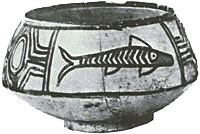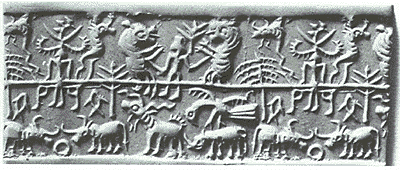
9. An "Early Harappan" polychrome pot with fish design from Nal, South Baluchistan
If the 'fish' pictograms of the Indus script generally meant 'star', why was the meaning 'star' not expressed directly with a 'star' pictogram as in the ancient Near East? Why did the Harappans in a more complicated way use a 'fish' pictogram and the rebus principle? One answer could be that though this method may appear more complicated to us, it probably did not appear so to the Indus scribes, in whose language the same word denoted both 'fish' and 'star'. But there is also another satisfactory answer to this question.
In the Sumerian script, the 'star' pictogram means not only dingir 'god' but also anu 'sky', and it seems that the 'star' pictogram originally was the exclusive symbol and attribute of the sky-god Anu. As Anu was the leading divinity of the Sumerian pantheon, his symbol started also meaning 'godhead', and then 'god' in general.
The 'fish' pictogram of the Indus script appears to have had a somewhat similar background. The reason why 'fish' and not 'star' was selected to represent the concept of 'god' seems to be that in the Early Harappan religion the fish occupied a central position: fish is one of the most popular motifs of the Early Harappan painted pottery (Fig. 9). As the aquatic animal par excellence, it appears to symbolize the God of Waters. The importance of this deity in the Harappan pantheon is proved by his popularity in the Harappan iconography.
The famous "Proto-Siva" wears the horns of a water-buffalo, another animal closely associated with water.

10. The Harappan "Proto-Siva" depicted on a seal from Mohenjo-daro.
In one Indus-type cylinder seal from the Near East, this buffalo-horned deity is surrounded by a pair of buffaloes, a pair of snakes, and a pair of fish (drawn exactly like the 'fish' pictograms of the Indus script).

11. Impression of an Indus-style cylinder seal of unknown Near Eastern origin.
In a triangular amulet from Mohenjo-daro, the same deity, squatting in "Proto-Siva's" "yoga posture", is flanked on either side by a fish, an alligator, and a snake.

12. One side of a triangular amulet from Mohenjo-daro.
In a comparable fashion, the fish (sometimes alone, but usually placed in a river flowing out of the god's shoulders) characterizes the Sumerian water god Enki in the Mesopotamian seal glyptics. The water-god Varuna of the later Indian mythology is likewise said to be the lord of all sorts of aquatic monsters. We can be sure that, like Enki and Varuna, the Harappan "Proto-Siva" was not merely the god of waters, but had other important aspects as well. It seems probable that he was also the god of death and fertility: the buffalo, fish and alligator associated with the Indus deity had such associations later.
[Originally published as Parpola, Asko (1988) Religion reflected in the iconic signs of the Indus script: penetrating into long-forgotten picto+graphic messages. Visible Religion 6: pp. 114-135.]
